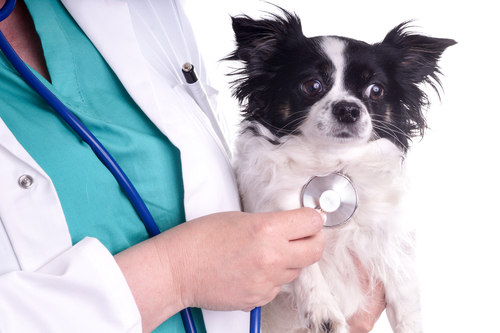Have you ever taken your lame dog to the vet and when you arrived she was not limping anymore? Or not even acting like she felt bad, even though she was lying around at home? You are not alone. This phenomenon happens every day at my hospital. We joke with clients and say that the ramp accessing our front door is “magic”. It may seem like your dog is just trying to make you look crazy for bringing her to the vet, but there is a physiological explanation for this occurrence.

Most dogs get excited and even anxious about travel and seeing the vet. It is a change to the normal routine to pile into the car and go somewhere. Your body language (to which your dog is very tuned) is screaming that you are worried about him. You know it is because he is sick or hurt, but he doesn’t and he wonders if maybe he should worry too. When dogs feel stress or excitement, their bodies release a hormone called epinephrine. Epinephrine is a part of the sympathetic nervous system.
The sympathetic nervous system plays a role in helping animals deal with situations of stress. It is the sympathetic nervous system that creates the headlines about people lifting heavy objects from trapped children or exhibiting super human strength. We hear about this system called the “fight or flight” response. In order to best prepare a body to handle new situations, this process triggers predictable responses designed to improve outcomes and prepare us to respond rapidly.

These effects include increased blood pressure and blood flow (to make sure all important organs are well supplied), increased metabolic rates (so that all the cells are operating optimally), increased muscle strength (in case you need to run or fight) and increased mental activity (so you can devise an escape plan).
Even if your dog is not very stressed or afraid at the vet office, it does not take much stimulation of the sympathetic nervous system to trigger its effects. These effects help your dog to temporarily override lameness and appear more alert than at home.
This is a natural and normal adaption of animal systems and a typical part of my day. Current technology can help if you know that this may occur. When you notice that your dog is limping, take a quick video on your smart phone to show the vet at your visit. Remember, the law requires your vet to actually examine the dog before he or she can prescribe something, so your video is meant to supplement the exam and not substitute for it, but sometimes seeing my patients videotaped in their home can help me get a clearer picture of the issue.

Be prepared for your dog to act much less sick, lame or sore when you get to the office and know that his sympathetic nervous system is taking the lead. Don’t worry. Your dog is not mocking you. It is an automatic and subconscious response that she cannot consciously control. Rest assured that your vet knows this happens and will account for the phenomenon during the examination to still get to the bottom of the problem.
You can do your part by taking video at home of any subtle lameness or signs of illness and travel regularly with your dog so that travel excitement is minimized. And remember, don’t blame the dog!
Please look me up on Twitter, Facebook and Google+ . I love hearing about your pets!
